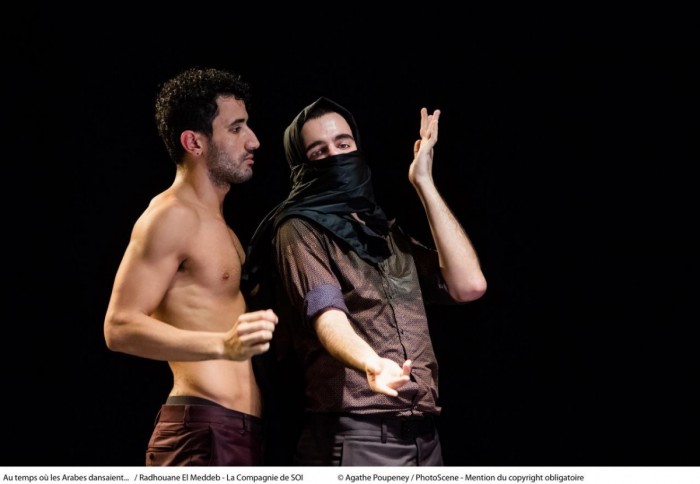When the Arabs Used to Dance is a somewhat contradictory title for a dance performance, using the past tense for something that is yet to come. The title is not the only part of El Meddeb’s new performance that seems out of place – the four male dancers use styles that seem strikingly female, with belly-dancing and gyrating hips, coquettish movements and sensuous looks. Later in the performance, this is further juxtaposed against archival footage from the Arab ‘Golden Age’ of cinema, including popular Arab actresses dancing and posing, which is played behind the dancers.
Beyond mere shock or intrigue value, El Meddeb’s contrasts here are reflective of what is, in its very essence, a performance that is consistently reflexive. Inspired by the films, music and culture of the Arab world in the 60s and 70s, when women and artists in particular were freer than today, El Meddeb’s dance is almost a conversation between the then and the now. The two eras are made to feel almost separate through the contrast of the lavish costumes and backdrops of the archival footage compared to El Meddeb’s four dancers, who are dressed in simple western clothes on a plain black stage. But ultimately, the movements are the same – sensual and energetic. In a brief conversation with the Shubbak Festival blog, El Meddeb described his performance as “a play that uses the past to tell the present”.
The dance itself is a journey – the beginning bare and simplistic with the movements pared down to their most basic elements and the sounds of dance steps, moving bodies and breathing punctuating the silence. The movements are slow, expressive and mindful; the dancers’ faces are blank and their bodies in a distinct line, dislocated from one another. As the dance progresses, the movements become faster and more urgent, their bodies becoming closer and in time with one another. The performance seems punctuated, for me at least, at the point where one dancer removes his shirt and wraps it around the waist of a fellow dancer, whilst his hips move rhythmically in a belly dance. The first dancer then removes the shirt from his waist and instead wraps it around the dancer’s face, first creating a hijab; then moving a sleeve to cover the lower part of his face as a niqab; and finally pulling the shirt entirely over his face. This sequence seems to be a metaphor for El Meddeb’s feelings on the past and present. He describes it as “the violence of the world entering the cardboard scenery […] bringing to the end a time that was an illusion, a sweet illusion”.

It becomes clear, then, that El Meddeb’s intriguing title does not declare that Arabs have stopped dancing, only that they are dancing to a different beat, in a different time and a different world. When Arabs Used to Dance is both a warning for the future and a celebration of the past and, for now, the Arabs are dancing on the precipice.
-
When the Arabs Used to Dance will take place on Wednesday 15 July 2015 at 8pm at The Place.
Aimee Dawson is this year’s Shubbak Festival writer-in-residence. She is a London-based writer and blogger on contemporary art from the Middle East and North Africa and the Editorial Assistant at Ibraaz.org.